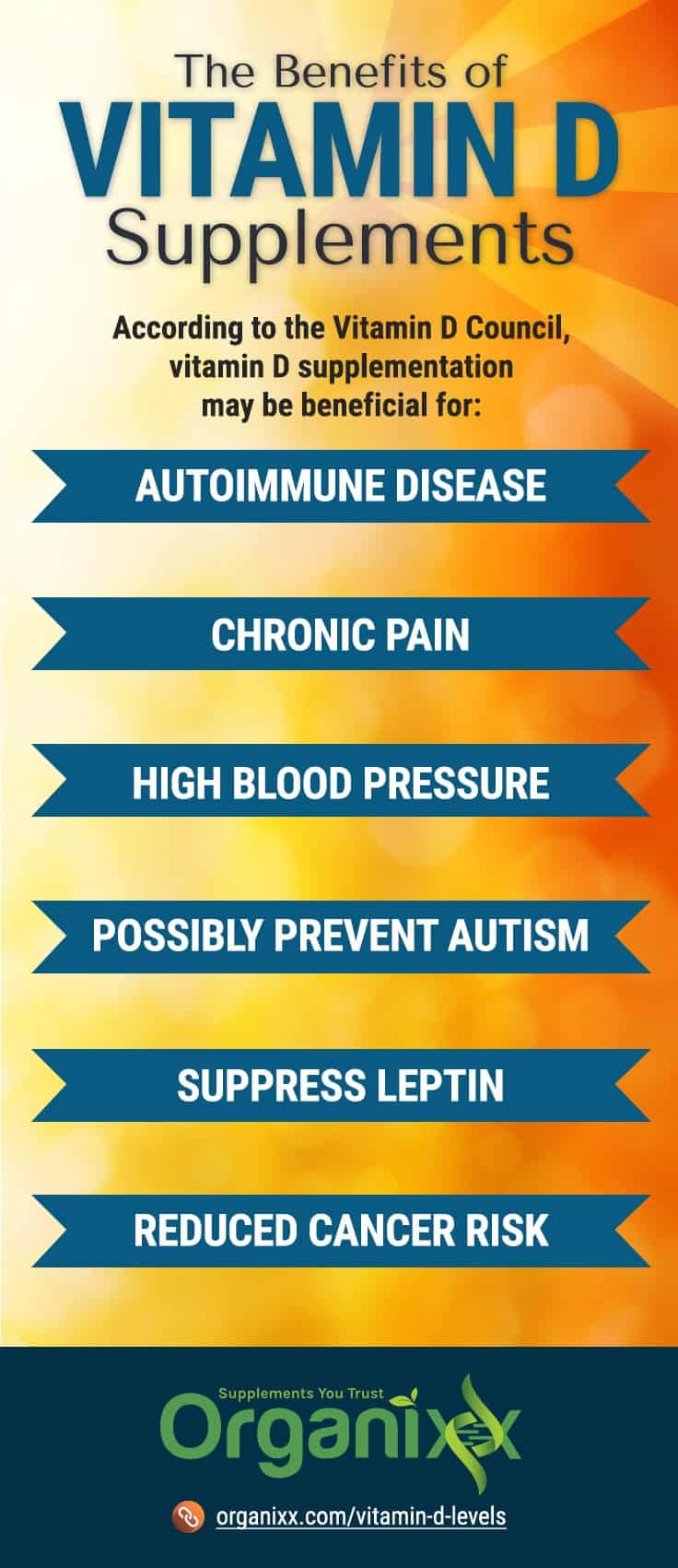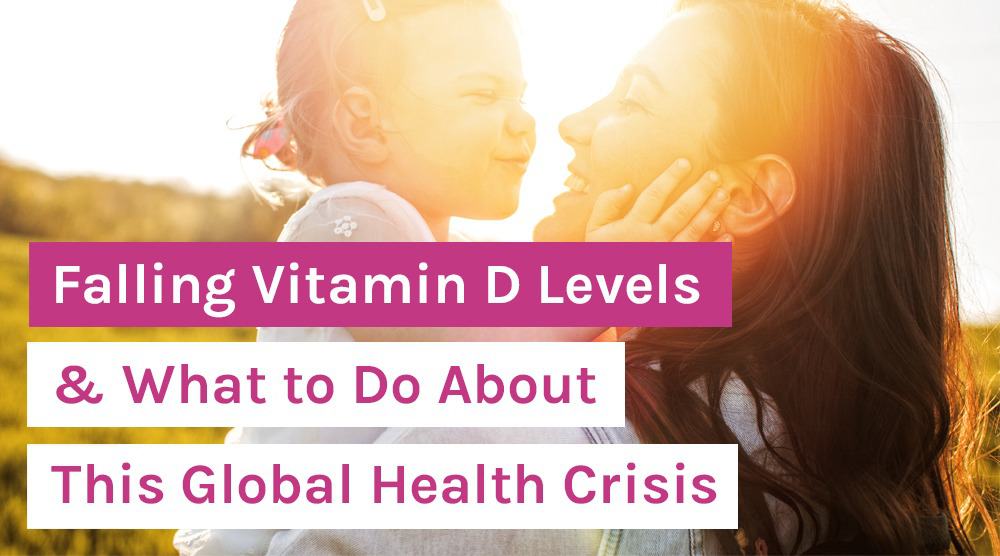Falling Vitamin D Levels & What to Do About This Global Health Crisis
In a hurry? Click here to read the Article Summary...
What are the causes of vitamin D deficiency and why is this something you need to be concerned about? Vitamin D may be one of the most important hormonal substances for your body. Not just for your muscular-skeletal system, but to help prevent a long list of chronic conditions including cardiovascular disease, diabetes, allergies, depression, Alzheimer’s, autoimmune conditions, cancer, and even Covid-19. And here’s the sad and potentially dangerous reality… vitamin D levels have reached an all-time low. Not just in the United States, but worldwide – even in climates with plenty of sunshine year round!
Vitamin D Levels Are Decreasing
 A 2009 study reported on vitamin D levels in the U.S. for both men and women from 1988 – 2004.
A 2009 study reported on vitamin D levels in the U.S. for both men and women from 1988 – 2004.
The report was assembled by researchers from the University of Colorado, Johns Hopkins School of Medicine, and Harvard Medical School and published in the prestigious medical journal, the Archives of Internal Medicine. In particular, the researchers looked at statistics from the U.S. government’s National Health and Nutrition Examination Survey.
They found that the number of Americans who had vitamin D levels which were “sufficient for overall health” was roughly 45% in the late 1980s. Granted, this is not the greatest percentage, but it still meant that close to half of all Americans has sufficient amounts of vitamin D in their system at that time.
The shocker came when the researchers analyzed the numbers for 2004. A mere 16 years later, the percentage of Americans of all ages who had adequate vitamin D levels had been cut almost in half to only 23%.
The story is the same globally. According to a 2015 report published by the University College of Medical Sciences at Guru Tegh Bahadur Hospital in Delhi, India:
“High rates of biochemical vitamin D deficiency or insufficiency among healthy individuals have been reported in large-scale studies from all parts of the world – the United States, Canada, South America, Europe, Australia, the Middle East, South Asia, and Africa. Severe vitamin D deficiency is common in China, India, South America, and the Middle East…”
Who Determines How Much Vitamin D You Need?
The cutoff which defines vitamin D deficiency varies greatly between studies, and has even undergone some controversy in recent years.
In 2015, UC San Diego and Creighton University challenged the National Academy of Sciences (NAS) Institute of Medicine (IOM), claiming that their Recommended Daily Allowance (RDA) for vitamin D, which has become the standard in the United States, was off by more than a factor of ten.
While the NAS states that 600 IU/day through age 70 (and 800 IU/day for those older than 70) will suffice for health, the UCSD and Creighton researchers both state that the RDA should be more along the lines of 7,000 IU/day (which would maintain roughly 60 ng/ml vitamin D in the blood).
While some experts and institutions warn of adverse effects of raising vitamin D levels past 50, other studies verify the potential healing power of higher amounts of vitamin D.
For instance, a 2014 University of California, San Diego breast cancer study published in the journal of the American Association for Cancer Research found that when vitamin D blood levels in the blood were raised to 50ng/ml from 25ng/ml, there was a corresponding 83% reduction in breast cancer. Similar results were discovered for colon cancer in lower amounts (but still at amounts that exceeded the NAS Recommended Daily Allowance).
Vitamin D Deficiency Causes
There are certain genetic conditions which can cause malabsorption of vitamin D. In particular, researchers at the Technical University of Denmark found that two genes (CYP2R1 and GC) may influence how much vitamin D remains in a person’s system.
The worldwide pandemic of vitamin D deficiency is not caused by genes alone, however. For the majority of people, lifestyle − including lack of sunlight exposure and poor dietary choices − is what causes severe vitamin D deficiency and its sometimes life-threatening consequences.
Can You Make Enough Vitamin D From Sun Exposure?
 In reality, vitamin D is not a vitamin. It is a steroid hormone with the ability to affect over 100 genetic functions in the body, not the least of which is bone development and calcium absorption.
In reality, vitamin D is not a vitamin. It is a steroid hormone with the ability to affect over 100 genetic functions in the body, not the least of which is bone development and calcium absorption.
When the skin is exposed to the ultraviolet (UVB) rays of the sun, it causes a chemical reaction. Pro-hormones in the skin, specifically a form of cholesterol called 7-dehydrocholesterol (7-DHC), absorb the UVB, causing them to convert into cholecalciferol, or vitamin D3 (which we will talk about more in the next section).
Everyone is different, and so are the variables that contribute to how much sun exposure is healthy for each person. According to the National Institutes of Health, between 5 and 30 minutes of “unprotected” sun on as much of your bare skin as possible during peak sunlight hours (i.e. as close to midday as possible), should be enough to produce adequate amounts of vitamin D3.
Americans Spend 97% of Their Their Time Indoors
Yet how many of us are really able to go out in the sun for a half an hour every day? According to the U.S. Environmental Protection Agency, Americans spend about 97% of their time indoors, either inside their homes, in their offices or in the car.
When most individuals do go outside, they are more likely to limit their sun exposure by wearing sunscreen (which comes with its own toxic hazards) or not sitting directly in the sun at all for fear of skin cancer.
This modern trend is proving to be detrimental to vitamin D levels worldwide, and to health. It is estimated that we should be able to get about 90% of our vitamin D from sun exposure.
However, even if we were able to get the recommended daily allowance of sun exposure every day, this amount may not be enough to restore already-existing deficiencies.
Kidney imbalance, gut-related conditions, toxin overload, and liver conditions such as fatty liver may affect absorption and conversion. For many people, sun exposure simply is not enough to ensure healthy, normal vitamin D levels.
Can You Get Sufficient Vitamin D From Food?
 Are you able to achieve normal vitamin D levels through diet? Well, yes and no.
Are you able to achieve normal vitamin D levels through diet? Well, yes and no.
There are a few foods, such as salmon and tuna, eggs, and fortified dairy, which contain vitamin D. And there may have been a time when the 10% of necessary vitamin D that did not come from sunlight could potentially come from the natural food we ate.
But because of the increasing rate of chronic conditions affecting the gut and detoxification pathways in our modern world, however, food as a substantial supplemental source of vitamin D may be a thing of the past.
Remember that substance called cholecalciferol mentioned before? That is really a “previtamin” form of D3. Before it can be converted into a form of vitamin D that can help the body, this previtamin must travel to the liver, where it will be metabolized and turned into 25-hydroxyvitamin D or 25(OH)D.
This is where the kidneys come into play. They are needed to convert 25(OH)D into 1,25-dihydroxyvitamin D or 25(OH)2D, the form of vitamin D that your body can finally use.
As you can see, there are a LOT of functions involved in the process of converting and utilizing the steroid hormone vitamin D. And most of these functions require a healthy digestive system as well as healthy detoxification pathways in the form of the liver and kidneys.
In a world where both kidney and liver disease as well as digestive imbalance is on the rise, there are a lot of places where problems can arise.
Case in point: roughly 20% of American adults and 10% of American children now have non-alcoholic fatty liver disease, which is linked to obesity and high fructose corn syrup in particular. Fatty liver disease is a precursor to cirrhosis of the liver and can significantly effect the ability of this organ to metabolize vitamin D.
When Are Vitamin D Supplements Necessary?
Most experts agree that it is a good idea in general to get your vitamin D levels checked by a qualified lab and consult with your doctor before engaging in vitamin D supplementation. For more and more individuals who are depleted in this essential hormone, however, vitamin D supplementation just makes sense.
According to the Vitamin D Council, vitamin D supplementation may be beneficial for autoimmune disease, chronic pain, high blood pressure and possibly even for preventing autism.
A Canadian study found a 60% reduction in cancer overall with the use of vitamin D. Finally, a 2014 University of South Florida College of Medicine study reported that: “vitamin D may be an effective agent to reduce obesity-associated cancer risks in women.”
Choosing the Best Vitamin D Supplement For Your Health Needs
The kind of supplement you choose is as important as your choice to supplement with vitamin D. Make sure your vitamin D supplement is in a bio-available form of vitamin D3, ideally with supplemental substances such as immune-boosters, detoxification aids, and vitamin K2 so that the vitamin D3 you take in has the best chance of doing its job.
Don’t be among the 75% of Americans − and the majority of the world population − that succumbs to the devastating effects of chronic Vitamin D deficiency.
Be smart and pro-active. Find out your D levels and then take action to get adequate sunlight exposure and eat to support your gut health and detoxification pathways.
Then, if you need to, choose a quality super-supplement that can not only balance your D3 levels but also ensure that what vitamin D3 you do take in gets processed by your body in the most efficient way possible for optimal health and disease prevention.
Turmeric 3D from Organixx provides you one of the most “bioavailable” forms of turmeric due to its unique fermentation process. This means your body experiences the maximum benefits of the purest, most potent turmeric available!

 Sources:
Sources:
Article Summary
Vitamin D may be one of the most important hormonal substances for your body as it helps prevent chronic conditions such as cardiovascular disease and cancer.
For the majority of people, lifestyle − including lack of sunlight exposure and poor dietary choices − is what causes severe vitamin D deficiency.
Vitamin D is not a vitamin. It is a steroid hormone with the ability to affect over 100 genetic functions in the body.
For many people, sun exposure is not enough to ensure healthy, normal vitamin D level. And food as a substantial supplemental source of vitamin D may be a thing of the past.
According to the Vitamin D Council, vitamin D supplementation may be beneficial for autoimmune disease, chronic pain, high blood pressure and possibly even for preventing autism.
The kind of supplement you choose is as important as your choice to supplement with vitamin D.




I look forward to your educational emails and excellent products. I have been advised by Sabre Sciences in Ca. for the past few years and was amazed to learn so much about myself through simple saliva testing. Do you offer that type of testing, as well?